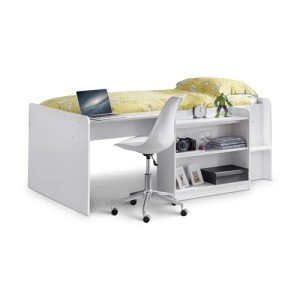Bunks: The Versatile Space-Saving Solution for Modern Living
In today's busy world, where metropolitan living spaces are diminishing and the need for adaptability and usefulness is increasing, bunks have actually emerged as a popular service. Bunks are not simply a type of bed; they represent an advanced approach to taking full advantage of space, promoting social interaction, and providing comfortable sleeping plans. This article will check out the different types of bunks available, their benefits, and how they can change both small and big living spaces.
Comprehending Bunks: What Are They?
Bunks, commonly described as bunk beds, are two or more beds stacked on top of each other. They are designed to save floor space, making them ideal for kids's spaces, hostels, and even adult living circumstances. Bunk beds are offered in numerous designs and configurations, from standard designs to modern-day, designer interpretations.
Types of Bunks
| Kind of Bunk | Description |
|---|---|
| Twin-over-Twin | 2 twin beds stacked on top of each other. Ideal for kids sharing a room. |
| Twin-over-Full | A twin bed on leading and a bigger full bed on the bottom. Great for accommodating guests. |
| Full-over-Full | Two full-sized beds stacked together. Perfect for older kids or adults. |
| L-Shaped Bunk Bed | Beds are arranged in an L shape, permitting a corner positioning and included space below. |
| Loft Beds | Only the leading bunk is present, leaving space for a desk, couch, or storage underneath. |
| Triple Bunk Beds | Three beds stacked vertically, exceptional for maximizing vertical space. |
Benefits of Using Bunks
- Space Efficiency: Bunks are designed to utilize vertical space, making them ideal for little bedrooms or houses where floor space is limited.
- Economical: Investing in a bunk bed can be more cost-effective than acquiring multiple different beds, specifically for growing households or those with frequent guests.
- Flexible Designs: Many bunks come with add-ons, such as desks, storage drawers, or futons, permitting flexible usage of the area.
- Social Interaction: Bunk beds invite camaraderie amongst brother or sisters and good friends, fostering a sense of connection.
- Innovative Use of Space: Bunk beds encourage imagination in space design, enabling for spirited themes and vibrant design that can make a bed room feel special and inviting.
Practical Considerations
- Height Limitations: When selecting a bunk bed, it is important to consider the height of the ceiling in the space. Measure the space to make sure there is appropriate clearance above the leading bunk for safety and convenience.
- Weight Restrictions: Each bunk has a particular weight limitation. Parents ought to examine the weight of those using it, especially when it comes to adults or heavier teenagers sharing the bed.
- Safety Features: Features such as guardrails, tough ladders, and security certifications are crucial for guaranteeing the bunk bed's security, especially for more youthful users.
Bunks for Various Living Situations
Household Homes
In household homes, bunks use a useful solution for brother or sisters sharing a room or accommodating pajama parties. Bunk beds can be stylishly incorporated into a child's space while offering sufficient room for play.
Hostels and Vacation Rentals
For hostels and vacation rentals, bunk beds maximize sleeping arrangements without jeopardizing comfort. Such setups provide a cost-efficient method to accommodate a larger number of guests.
College Dormitories
In college dormitories, bunks assist take advantage of the minimal square footage available, permitting more room to socialize and study.
Little Apartments
In small metropolitan houses, lofted bunk beds develop extra space for living locations, workspaces, or storage, making life more workable in compact environments.
Upkeep and Care of Bunks
Maintaining a bunk bed is vital for guaranteeing its longevity. Here are a few pointers:
- Regular Inspections: Check for any loose screws or bolts and tighten them as necessary.
- Tidiness: Dust and tidy the bunks regularly to prevent allergens and ensure a clean sleeping environment.
- Mattress Care: Use a quality mattress protector to maintain health and extend the life of the mattress.
- Age Appropriateness: Upgrade to a bigger, more strong bunk as kids grow or when the current plan no longer fulfills the needs of its residents.
Regularly Asked Questions (FAQs)
1. Are bunk beds safe for kids?
Yes, bunk beds can be safe for kids if they are constructed with security functions like guardrails and a stable ladder. Always supervise younger kids when they are utilizing bunk beds.
2. What age is appropriate for a child to sleep on the leading bunk?
Most makers recommend that kids under the age of 6 need to not sleep on the upper bunk due to security issues.
3. How much weight can bunk beds usually hold?
Weight capabilities differ based on the design and materials but generally range from 200 to 400 pounds. Always check the maker's guidelines.
4. Can bunk beds be separated into two single beds?
Lots of bunk beds are developed to be convertible, enabling them to be separated into 2 specific beds. It's important to inspect the item specifications before acquiring.
5. What type of mattress is best for a bunk bed?
A medium-firm mattress is typically suggested as it provides adequate assistance without being too heavy or soft, which can present security concerns.
Bunks are more than just beds. They are innovative space-saving options that accommodate the requirements of modern-day living. With Toddler Bunk Beds , they offer comfort and performance for households, guests, and individuals alike. By focusing on security and upkeep, owners can ensure that their bunk beds become a valued part of their living spaces for lots of years to come. Whether for playful children or accommodating guests, bunk beds use a trendy and useful solution to the challenge of limited space.

